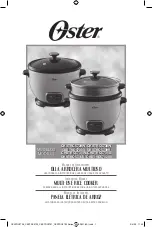
3
INSTRUCTIONS FOR INSTALLATION
The following instructions should be read by a qualifi ed technician
to ensure that the appliance is installed, regulated and serviced
correctly in compliance with current standards.
Important: Remember to unplug the appliance from the
mains before making adjustments or doing maintenance.
POSITIONING
Important:
This unit may be installed and used only in per-
manently ventilated rooms in compliance with current National
Regulations. The following requirements must be observed:
a)
The room must be equipped with an exhaust system that
vents the combustion fumes to the outside. It may consist of
a hood or an electric fan that automatically starts each time
the appliance is turned on.
Flue or Branched Flue System
Directly to the Outside
(only for cooking appliances)
b)
The room must also have a system to permit proper air circu-
lation, needed for combustion to occur normally. The fl ow of
air needed for combustion must not be less than 2 m
3
/h per
kW of installed power. The air circulation system may take
air directly from the outside by means of a pipe with an inner
cross section of at least 100 cm
2
; the opening must not be
able to be accidentally blocked. For those appliances not
equipped with a safety device for accidental fl ame loss, the
ventilation apertures must be increased by 100%, with the
minimum being 200cm
2
(Fig. A). The system can also provide
the air needed for combustion by indirect means, i.e. from
adjacent rooms fi tted with air circulation tubes as described
above. However, these rooms must not be common rooms
or bedrooms. (Fig. B).
Detail A
Adjacent
Room to
Room
be Ventilated
A
Examples of Ventilation Openings
Increased Opening Between
Comburent Air
Door and Floor
Fig. A
Fig. B
c)
Intensive and prolonged use of the appliance may result in the
need for supplemental air circulation, e.g. opening windows
or increasing mechanical venting (if present).
d)
Liquifi ed petroleum gas is heavier than the air and, therefore,
settles downwards. Thus, rooms containing LPG cylinders
must also be equipped with apertures to the outside for ven-
tilation of gas in the case of leaks. LPG cylinders must not,
therefore, be installed or stored in rooms or storage areas that
are below ground level (cellars, etc.) whether they are partially
or completely full. It is a good idea to keep only the cylinder
being used in the room, positioned so that it is not subject
to heat produced by external sources (ovens, fi replaces,
stoves, etc. ) which are able to increase the temperature of
the cylinder above 50°C.
FITTING THE FEET
Cookers are equipped whith adjustable feet to be screwed into
their front and rear corners respectively. The feet allow the height
of the appliance to be adjusted, in order to set it fl ush whith the
adjoining unit, to level it whith other worktops ans to ensure even
distribution of the liquids in pans.
INSTALLING THE COOKER
The appliance can be installed next to cabinets, provided they
are not taller than the hob. If the cooker is placed in contact
with walls or the sides of adjacent cabinets, they must be capa-
ble of withstanding a rise in temperature of 50°C above room
temperature. For proper installation of the cooker, the following
precautions must be taken:
a)
Kitchen cabinets installed next to the cooker that are higher
than the top of the hob, must be at least 200 mm from the
edge of the hob itself.
b)
Hoods must be installed according to the requirements in
the installation manual for the hood and, in any case, at a
minimum height of 650 mm.
c)
If the hood is installed below a wall cabinet, the latter must be
at least 700 mm (millimetres) above the surface of the hob.
Cabinets installed adjacent to the hood must be at least 420
mm.
MAKING THE GAS CONNECTION
The appliance should be connected to the mains or to a gas
cylinder in compliance with current directives. Before making
the connection, check that the cooker is regulated for the gas
supply you are using. If not, follow the instructions indicated
in the paragraph “Converting to Different Types of Gas." On
some models the gas supply can be connected on the left or on
the right, as necessary; to change the connection, reverse the
position of the hose holder with that of the cap and replace the
gasket (supplied with the appliance). When using liquid gas from
a cylinder, install a pressure regulator which complies with the
National Regulations.
Important:
Check that the supply pressure complies
with the values indicated in table 1 “Burner and Nozzle
Char
acteristics” since this will ensure safe operation, correct




































